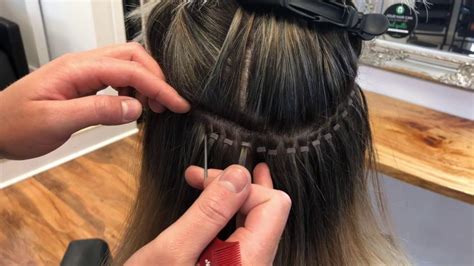Human Hair Extensions: A Historical Perspective
Since the days of ancient Egypt, humans have sought ways to enhance their appearance and express their individuality through hair. The practice of utilizing human hair extensions dates back several centuries, with evidence suggesting its use by Egyptian pharaohs and noblewomen.

In the 16th century, European women popularized the use of hair extensions, often made from the hair of servants or purchased from poor women. These extensions, known as “borrowed hair,” were intricately designed and sewn into the wearer’s own hair to create elaborate hairstyles.
The 21st century has witnessed significant advancements in the production and availability of human hair extensions. Modern techniques, including micro loops, tape-ins, and fusion methods, have made extensions more accessible and versatile than ever before.
The Global Human Hair Extension Market: Size and Growth
The global human hair extension market is a multi-billion dollar industry, with a projected value of over $20 billion by 2027. The increasing demand for natural-looking, high-quality extensions has fueled this growth, particularly in regions like the United States, Europe, and Asia.
Types and Sources of Human Hair Extensions
Various types of human hair extensions are available, each with unique characteristics:
- Remy Hair: Derived from bundles of hair that have been kept aligned in the same direction, Remy extensions minimize tangling and maintain a natural, healthy appearance.
- Non-Remy Hair: Consists of unaligned hair strands that may result in more tangles and shedding.
- Virgin Hair: Hair that has never been chemically processed, dyed, or styled, making it soft, shiny, and long-lasting.
- Chinese Hair: Known for its thick, straight texture, Chinese hair is widely used in the production of hair extensions due to its availability and affordability.
- Indian Hair: Renowned for its silky, smooth texture, Indian hair is a premium choice for creating natural-looking extensions.
- European Hair: Considered the highest quality, European hair is fine, soft, and naturally blonde, making it ideal for blending with light-colored hair.
Benefits of Human Hair Extensions
- Versatility: Extensions allow you to experiment with different lengths, colors, and styles without damaging your natural hair.
- Hair Health: Extensions can protect your natural hair from heat styling, chemical treatments, and excessive brushing.
- Boosted Confidence: Extensions can enhance your appearance and boost your self-esteem by adding volume, length, and thickness to your hair.
- Time-Saving: Extensions can save you time on styling, allowing you to achieve a polished look with minimal effort.
- Long-Lasting: With proper care and maintenance, human hair extensions can last for several months or even years.
Common Mistakes to Avoid
- Over-Washing: Avoid washing extensions too frequently, as it can strip away natural oils and cause dryness.
- Harsh Products: Use sulfate-free shampoos and conditioners specifically designed for hair extensions.
- Tangling: Gently brush extensions with a wide-tooth comb to prevent tangles and shedding.
- Heat Damage: Limit the use of heat styling tools on extensions to avoid damage.
- Poor Installation: Ensure that extensions are installed professionally to avoid damage to your natural hair.
Tips for Choosing and Maintaining Human Hair Extensions
- Match Your Hair Type: Select extensions that match the texture and color of your natural hair for a seamless blend.
- Consider Your Lifestyle: Choose extensions that suit your lifestyle and maintenance routine.
- Use the Right Products: Invest in high-quality shampoos, conditioners, and styling products specifically formulated for hair extensions.
- Protect from the Elements: Wear a hat or scarf to protect extensions from sun exposure and humidity.
- Get Regular Maintenance: Visit your stylist for regular trims, tightening, and deep conditioning to keep extensions looking their best.
Creative Applications of Hair Extensions
Beyond enhancing your current hairstyle, hair extensions offer unique opportunities:
Enhance Braid Styles: Create intricate, eye-catching braids by incorporating extensions for added length and thickness.
Experiment with Color: Add pops of color or ombre effects to your hair without the commitment of chemical dying.
Create Volume and Thickness: Amplify fine or thinning hair by adding volume and thickness with extensions.
Accessorize with Flair: Use extensions to wrap around buns, ponies, and updos for a touch of elegance.
Table 1: Types of Human Hair Extensions
| Type | Characteristics |
|---|---|
| Remy | Aligned hair strands, minimizing tangling |
| Non-Remy | Unaligned hair strands, prone to tangles |
| Virgin | Unprocessed hair, maintaining natural shine and softness |
Table 2: Sources of Human Hair Extensions
| Source | Characteristics |
|---|---|
| Chinese | Thick, straight texture |
| Indian | Silky, smooth texture |
| European | Fine, soft, naturally blonde |
Table 3: Benefits of Human Hair Extensions
| Benefit | Description |
|---|---|
| Versatility | Multiple styling options without damaging natural hair |
| Hair Health | Protects hair from heat, chemicals, and excessive brushing |
| Confidence Boost | Enhances appearance and boosts self-esteem |
| Time-Saving | Reduces time spent styling |
| Long-Lasting | Proper care extends lifespan for several months or years |
Table 4: Mistakes to Avoid with Human Hair Extensions
| Mistake | Description |
|---|---|
| Over-Washing | Strips natural oils, leading to dryness |
| Harsh Products | Damages extensions with sulfates and harsh chemicals |
| Tangling | Results from improper brushing |
| Heat Damage | Excessive heat styling weakens hair |
| Poor Installation | Causes damage to natural hair |
